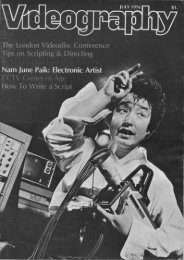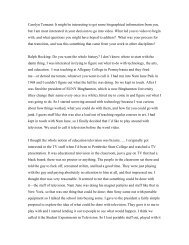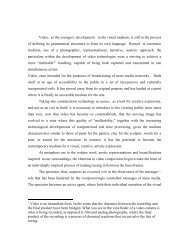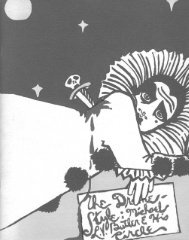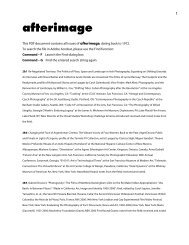At Arm's Length: (Taking a Good Hard Look at) Artists' Video
At Arm's Length: (Taking a Good Hard Look at) Artists' Video
At Arm's Length: (Taking a Good Hard Look at) Artists' Video
- No tags were found...
You also want an ePaper? Increase the reach of your titles
YUMPU automatically turns print PDFs into web optimized ePapers that Google loves.
In part precisely because of video art's struggle for legitim<strong>at</strong>ion, and an inevitabledefensiveness in its early years, the form has been concerned to assert its individual anddistinctive histories and traditions. As a consequence, video has been confined to a limitedcontext, and seen as separ<strong>at</strong>e from developments in film, in television and in other movingimage media like digital anim<strong>at</strong>ion. There are signs th<strong>at</strong> this is beginning to change, and twomajor European exhibitions in the autumn of 1990—Passages d'Image <strong>at</strong> the Centre GeorgesPompidou, Paris and The First Biennial of the Moving Image <strong>at</strong> the Reina Sofia Centre inMadrid—specifically address the rel<strong>at</strong>ionships between video and other forms of the movingimage. But in the past the understanding of video as separ<strong>at</strong>e from rel<strong>at</strong>ed media has meantth<strong>at</strong> video in the eyes of both its cre<strong>at</strong>ors and its critics, has tended to be cut off from likelyenrichment by other elements of our contemporary moving image culture.If the dominant <strong>at</strong>titudes are to change, as' l believe they should, the shift maycontribute to the possibly inevitable, and probably positive, dissolution of video art's currentidentity. <strong>Video</strong> art was never defined or legitim<strong>at</strong>ed internally either solely by technology orby a shared language. Nor, as I have argued, should it have been defined and legitim<strong>at</strong>edprimarily by reference to the external evil of television. Its identity, today as for much of itshistory, is .an institutional one, formed and sustained by now compar<strong>at</strong>ively well-establishedstructures of cur<strong>at</strong>orship, criticism and distribution. Even a slowly developing market, forinstall<strong>at</strong>ions and for archive-quality museum copies of tapes, is beginning to make acontribution to this identity.The primarily institutional n<strong>at</strong>ure of video art's identity today may inhibit the19





